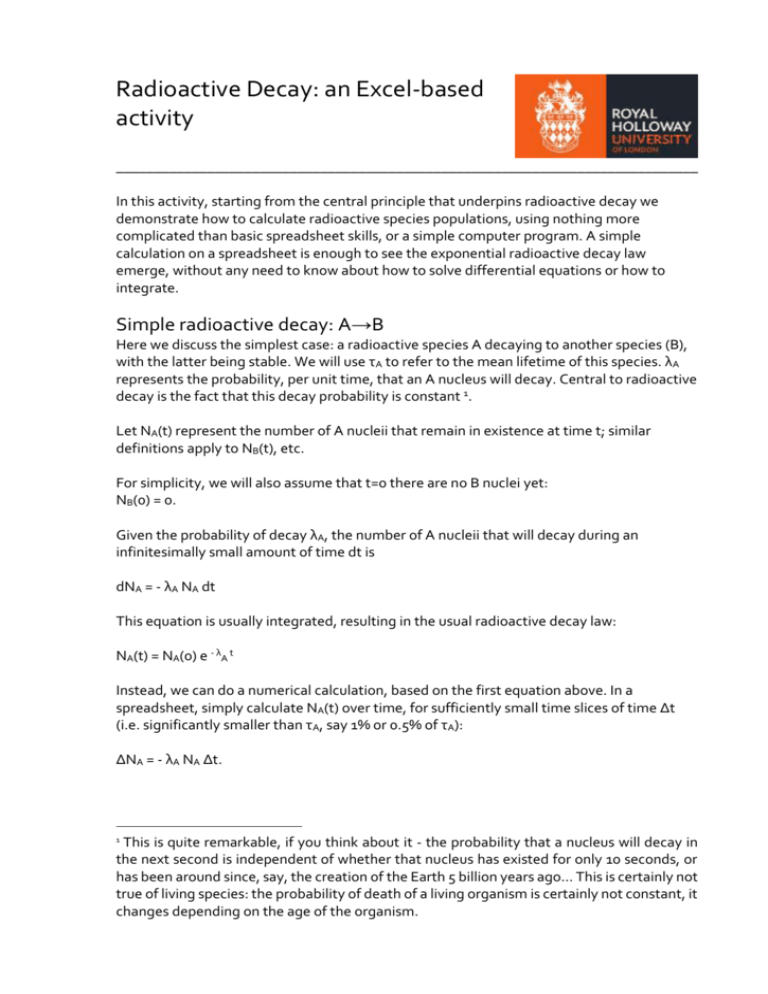Radioactive Decay Activity
advertisement

Radioactive Decay: an Excel-based activity _____________________________________________________________________________ In this activity, starting from the central principle that underpins radioactive decay we demonstrate how to calculate radioactive species populations, using nothing more complicated than basic spreadsheet skills, or a simple computer program. A simple calculation on a spreadsheet is enough to see the exponential radioactive decay law emerge, without any need to know about how to solve differential equations or how to integrate. Simple radioactive decay: A→B Here we discuss the simplest case: a radioactive species A decaying to another species (B), with the latter being stable. We will use τA to refer to the mean lifetime of this species. λA represents the probability, per unit time, that an A nucleus will decay. Central to radioactive decay is the fact that this decay probability is constant 1. Let NA(t) represent the number of A nucleii that remain in existence at time t; similar definitions apply to NB(t), etc. For simplicity, we will also assume that t=0 there are no B nuclei yet: NB(0) = 0. Given the probability of decay λA, the number of A nucleii that will decay during an infinitesimally small amount of time dt is dNA = - λA NA dt This equation is usually integrated, resulting in the usual radioactive decay law: NA(t) = NA(0) e - λA t Instead, we can do a numerical calculation, based on the first equation above. In a spreadsheet, simply calculate NA(t) over time, for sufficiently small time slices of time Δt (i.e. significantly smaller than τA, say 1% or 0.5% of τA): ΔNA = - λA NA Δt. This is quite remarkable, if you think about it - the probability that a nucleus will decay in the next second is independent of whether that nucleus has existed for only 10 seconds, or has been around since, say, the creation of the Earth 5 billion years ago... This is certainly not true of living species: the probability of death of a living organism is certainly not constant, it changes depending on the age of the organism. 1 It is a straightforward matter, with a spreadsheet, to calculate ΔNA for a given instant in time, then take that away from NA, and then repeat for the next time slice, over and over again: ΔNA(t + Δt) = NA(t) + ΔNA(t) If you chart NA over time, clear exponential decay will be apparent. The number of B nuclei decay will increase in time. In fact for every time slice the number of B nuclei will obviously increase by exactly the same amount as the number of A nuclei has decreased – for every A nucleus that disappears, a B nucleus will appear. Therefore we have ΔNB = - ΔNA It is therefore also trivial to calculate NB for every time slice Δt and plot its evolution in time. Decay Chain A → B → X In this case, the daughter species B is itself unstable, and will itself decay (with its own decay probability λB) to another species X, which we deem to be stable. Clearly, as before we, the decrease in the number of A nuclei in any time slice is given by ΔNA = - λA NA Δt At any given point in time, the number of B nuclei will increase due to the decay A → B, but at the same time will decrease due to the decay B → X: ΔNB = - ΔNA – λB NB Δt Every time a B nucleus decays, an X nucleus comes into existence, therefore: ΔNX = - ΔNB The equations above (with suitable initial conditions, e.g., NA(0) = 10,000 and NB(0) = NX(0) = 0) are all that is needed to calculate and then plot the time evolution of the species A, B, and X. Interesting cases to consider are when the two decay probabilities are the same (λA = λB) and when λA is either much smaller or much larger than λB (e.g., λA = 0.1 λB or λA = 10 λB). If you have any questions or comments on this activity, please contact physics.outreach@rhul.ac.uk. A sample spreadsheet to make these calculations and further particle physics resources can be found at royalholloway.ac.uk/PPresources.








